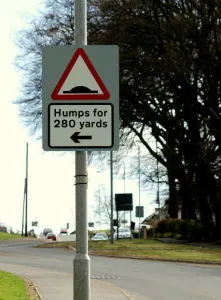Speed tables, speed bumps and speed humps are similar structures in concept and they all come with a purpose of lowering vehicle speeds in order to promote safer driving. However, they differ in length and height of the raised area that makes up the obstacle. A speed bump is designed to be used in lower speed areas such as private and residential roads as well as parking lots. The speed bump is rounded and varies from two to six inches in height. It is generally one to three feet in length from the front of the bump to the back. The width of a speed bump can vary as well – anywhere from one to ten feet. A speed bump’s design is such that it allows comfortable passage at very low speeds of around five mph.
While “speed bump” is probably the most widely used term, you may have noticed signs warning of an upcoming “speed hump” or “speed table”. Speed humps usually will not be greater than four inches in height and generally are 10-12 feet long. The speed hump serves a different purpose than the speed bump and allows the entire vehicle to sit on the obstacle before descending onto the other side of the roadway. Speed humps do not carry the same risk of a vehicle bottoming out, and allow for greater speeds than speed bumps. They are often used in residential areas with speed limits of 25 mph or less. They are employed to promote safety of streets on which people live, and to improve the traffic flow of residential areas, thereby improving the environmental quality as well.
Speed tables are roughly the same height (3-4 inches) but, as the name would imply, longer in length than speed humps. Speed tables generally have a relatively long flat top and up and down ramps that have a more subtle slope than humps, giving them the ability to accommodate automobiles traveling at higher speeds of up to 30 mph.
If your neighborhood has a speeding problem, there are procedures through the County in which you reside that allow residents to petition for the addition of one of these speed-reducing, safety-promoting measures.
I’m Ed Smith, a Sacramento automobile accident attorney. If you or someone you love has been injured in an accident caused by a speeding driver, call me now at 916.921.6400.
Check out our website at AutoAccident.com and our reviews on Yelp and Avvo, the attorney rating site.

